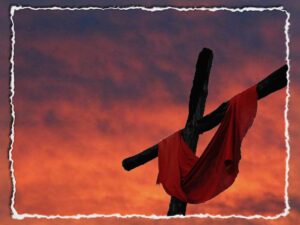A congregation of the United Church of Canada
Yr B ~ Lent 1 ~ Mark 8:34-38
Mark Twain once said, “It ain’t those parts of the Bible that I can’t understand that bother me, it is the parts that I do understand.” Today we get one of those parts. Today’s reading means exactly what it appears to mean. Our challenge is what to do with it, because it’s pretty heavy duty stuff.
Such is the typical content of the season of Lent.
Are you a fan? Do you enjoy Lent? Or do you endure it? Or do you avoid it?
I asked the Monday morning scripture discussion group – called the Porch – to describe what they liked about Lent. Two words that emerged were raw and intense. Lent certainly can be both of those things – if you let it.
Lent is the season during which we prepare for Holy Week. Jesus turns his eyes toward Jerusalem and so do we. We know that a cross awaits him. We know that it will not be pleasant or pretty. It will definitely be raw and intense. So why do we put ourselves through this?
The short answer is that if we don’t we will not only never understand Jesus and his teaching but we will get entirely the wrong idea about what this whole church and faith thing is supposed to be about. I’m going to work very hard today to dispel one of those things that I think we tend to get wrong – the cross. I hope you will find it helpful, but it’ll push your buttons!
Even if you never darken the door of a church there’s one aspect of Lent that’s pretty popular in the world – it’s the idea of giving something up for a while. I say something like this every year, because it really is that important. Giving something up is fine, but it kind of misses the point if that’s all you do.
And it really misses the point if you go around whining or bragging about how much you’re suffering for having ‘sacrificed so much’. If you do that you’re saying “Hey everybody, look at me, aren’t I a great person because I’m a bit uncomfortable!?” Does that sound like Jesus to you? If you’re going to give something up the point is to then trade that time for doing something spiritual – like praying, or helping people. Give up watching an hour of TV or internet and instead use that time to focus on God.
So where’d this whole idea of giving something up come from? Well, one place is today’s scripture reading. But I’m going to suggest that we can find deeper things in it.
Here’s the verse – it’s Mark 8:34 where Jesus says, “If any want to become my followers, let them deny themselves and take up their cross and follow me.”
Denying yourself doesn’t mean to forego eating chocolate, and it certainly doesn’t mean to demean yourself by calling yourself a vile worm. To deny yourself means to be less self-centred. It means to not always put your own desires first. It means opening your heart to God in prayer and saying “not my will but THY will be done” and really meaning it.
It’s not even a verse about sacrifice really, it’s a verse about surrender. About trust. About letting go and letting God. You can’t approach that by just giving something up for Lent. It’s more about giving yourself over for Lent.
“If any want to become my followers, let them deny themselves and take up their cross and follow me.”
What does Jesus mean with this provocative phrase “take up their cross and follow me”?
Well, it depends on which audience you consider. There are three.
The first audience is the crowd of people on the road with Jesus and his disciples. At this point they had no idea that he would be crucified. He may very well have had an inkling about it because he was poking at both the religious and the political establishment and when you poke hard enough they tend to fight back, and it rarely ends well for the poker. So while Jesus may have suspected there was a cross in his future, those travelling with him had no concept of Easter Sunday yet.
And we have to remember that as they were walking along that road it’s very likely that that road was lined with people being crucified. The Romans did it very publically, right along roadsides where people travelled, for the express purpose of intimidating and terrorizing the people. The cross wasn’t an abstract icon, and it certainly wasn’t a fashionable piece of jewelry, it was a very present, very ugly, very threatening reality for them. So for that first audience, when Jesus says people have to take up their cross in order to follow, he was probably physically pointing at actual people on crosses.
Now some will interpret the ‘taking up’ part as an acknowledgment that we all have to carry heavy burdens and deal with challenging things in life.
Frankly, I think that’s a pretty weak interpretation.
Jesus wasn’t pointing at people with burdens – he was pointing at people being executed – literally dying. The cross doesn’t mean struggle – it means death.
So now we have a paradox. If a cross means death then how can Jesus tell us to take up our cross and follow? You’ve got to go deeper to get it.
I think he means that in order to follow him – to embrace his Way and the kingdom of God that he reveals – one has to let go of one’s former way to embrace Jesus’ new Way. That means dying to what was so that we can be born (or reborn, if you like) into what will be.
The second audience to consider is the group of people receiving Mark’s gospel. Hopefully you’ll remember that Mark’s gospel was written at the same time that the Temple in Jerusalem was being destroyed by the Romans after the failed Jewish revolt – around the year 0070. Also, that group would have known more of the Jesus story by then too. They’d have known about his death on a cross, and about his resurrection.
So for the second audience the idea of taking up your cross had both the harshness of their reality of having to die to their old religious conventions – because the centre of their religion, the Temple, was destroyed – and it also had the promise of resurrection. And actual crosses were still very present so the image was still very visceral and powerful.
And for us, the third audience, we hear the story through the filters of 2000 years of theologizing. And our lives, by comparison, are pretty soft. We don’t have crosses lining our streets, and we don’t have churches being destroyed by our powerful oppressors. And so we’ve tended to interpret the cross in terms of carrying our burdens and struggles. And I think we’ve missed the point. The cross isn’t a ticket to heaven, it’s a symbol of a transforming rhythm of life.
Look, this is not easy theological stuff. I get it. But it’s really important.
We call ourselves an Easter people. That’s exactly right. We are! And that’s wonderful, and life changing, and beautiful.
The season of Lent reminds us that Easter doesn’t come out of nowhere. New life comes after old life is left behind. And the reality is, a reality that we tend to shrug off, that dying and rising are hard. Just ask someone who’s done something as basic as trying to quit smoking, or some similar vice. If it was easy to die to our old bad habits we’d have no bad habits!
In some ways, we have a tremendous advantage over those people on the road with Jesus while he was pointing at crosses and teaching. We know about Easter. We know that the cross of death is not the final word.
But knowing the whole story also has the effect of limiting us in some ways. I think we tend to associate the cross with Good Friday and Easter Sunday – in other words, we link the cross to the physical end of a life.
When Jesus was teaching about the cross on that road that afternoon he wasn’t the one on the cross. So even though he was pointing at physically dying people he was trying to spiritualize the dying – he was inviting people into a spiritual event – of taking up your cross and dying to former ways and joining him on the journey into abundant life in full awareness of the kingdom of God that is already all around us.
Ultimately, he wasn’t really pointing to a cross-shaped death – he was pointing to a cross-shaped LIFE! There’s a fancy theological word for that – cruciformity. If something is cruciform it means it’s in the shape of a cross. Maybe you’ve been in some churches whose architecture is cruciform?
But what does it mean to live a cruciform life?
It’s quite simply about a pattern of dying and rising. And instead of it just being focused on one big physical dying that happens at the end of your life, cruciformity points to a whole series of little dyings and risings that happen every day of your life. And as we die to those unhelpful things little by little, and embrace God’s kingdom little by little, our cruciform life reshapes us and renews us.
And as we become strengthened in God’s love, as the Spirit reshapes us and helps us exchange our will for God’s will, we might find ourselves embodying cruciformity. We might learn to greet the world with our arms wide open – knowing that to do so makes us extremely vulnerable and able to be hurt because we can’t defend or protect ourselves. And that sounds scary, but that’s the kind of love and posture that following Jesus is all about. Jesus lived a cruciform life every day – not just his last physical day.
He tells it to us plainly. “If any want to become my followers, let them deny themselves and take up their cross and follow me. For those who want to save their life will lose it, and those who lose their life for my sake, and for the sake of the gospel, will save it. For what will it profit them to gain the whole world and forfeit their life?”
The word translated as “life” here means your “soul” or “being” not your physical life.
If all you’re about is protecting what you’ve got then you’re all about saving your life (which is entirely natural and necessary on many levels) – but eventually you’ll lose it. And the word translated as “life” here means your “soul” or “being” not your physical life. Whether it’s possessions, status, or even your comfort and health, eventually all those things fade. They’re temporal. What does it profit you if you gain the whole world but miss out on something far greater?
Jesus speaks of the eternal. And he says that if we can take up our cross and die to our self-centredness, and our self-importance, and our obsessive self-gratification – a process that never happens in one fell swoop but requires a lifelong pattern of little dyings and letting-go’s – if we can live that cruciform rhythm then we can be transformed and reshaped into embracing the abundant life of the kingdom of God.
Yes, Holy Week and “the cross” looms. But along the way there are many crosses that mark the journey.
Welcome to the season of Lent!
A season that anticipates the joy of Easter by acknowledging the shape of the journey that gets us there.
And the shape that journey takes is cruciformity.
Amen.



